Introduction
The Gloster Gladiator was the last biplane fighter to enter service with the RAF, entering service in 1937 and was withdrawn from frontline service in 1941. By the time World War 2 got going, the RAF was equipped largely with the Hawker Hurricane, but the Gloster Gladiator still served an important role during the war having been the fighter that many British pilots cut their teeth on, and of course continued to serve during the war. In addition to service with the RAF the Gladiator served with the Royal Navy andmany European Air Forces. During the World War 2 the Gladiator served as partof many Commonwealth Air Forces with the Australian aircraft having a particularly noteworthy history. Lastly the Gladiator also flew with Chinese forces against the Japanese and won some incredible victories.
This release from ICM is the fourth Gloster Gladiator release in 1/32nd scale and sees the initial release available again, but this time around a set of figures is included. The figures in this release consist of two pilots and an officer in tropical uniform; happily two of the finishing options here cover aircraft based in Egypt.

Review
This offering is supplied in the now usual flip top cardboard box favoured by ICM with a second separate card lid with the artwork on it; as a modeller I do appreciate a well packaged offering and I feel ICM is one of the best in this respect. The artwork on the lid is very nicely done and will draw your eye to the box and provides a nice potential display setting. Inside the box is an instruction booklet with the decals protected between the pages and a separate sheet covering the figures included. The sprues are packed inside a re-sealable plastic bag with a further bag holding the clear parts for the aircraft and the figures in a bag of their own.
An examination of the contents leaves me happy as the plastic suffers from some flow lines which do not look or feel to have caused any issues with the finish of the parts. The clear parts of the model have a nice thinness to them and this has resulted in no obvious lens magnification that I could see across the parts. The decals have great colour but feel a little on the thick side which may result in issues during application. Two of the finishing options cover Egyptian based aircraft and so perfect for the figure set. Identification of a Mk I from a Mk II Gladiator:
Mk I
The engine is an 830 hp Mercury Mk X
Two bladed Watts propeller
Large prop spinner that can be removed
The MK II
The engine is an 830 hp Mercury Mk VIIIA
Fairey-Reed three-bladed propeller
Much smaller propeller spinner that is always in place
Vokes Air Filter used on both Mk I and II aircraft when serving in the desert; take note on which version you are building as this will be needed if using the provided figures.
The Aircraft
As with most models the construction begins with the cockpit and for the most part this area has been accurately detailed. The build of this area requires very little effort on the part of the modeller if built from the box, but there is plenty that can be added to improve the area. So let’s start with what is missing, inaccurate or needs help. The release arms for the cockpit doors need some help as the detail of the actuator is weak, but the structure present is very good. It is worth noting that the left hand door was the usual one to use as the one on the right was only really used in an emergency.
The frame detail in the cockpit is generally correct as regards structure, but the form could be greatly improved if you wish to go to work on it. Areas such as reinforcing shapes are missing from where they should be, but once closed up there is not much you can see. The instrument panel in the Gladiator is in two pieces. The upper panel is a perfect match for a Mk 1Gladiator in every detail, but the lower panel is haphazard in that most of what is there is generally accurate, but there is missing detail. Please note that the Mk II instrument is different and so do not confuse the two.
The feed shoots for the fuselage-mounted machine guns are missing, but the detail that is present is good enough for what can be seen, though there is plenty of room for improvement. The muzzles will need drilling out in all four machine guns located in the fuselage and under the wings, or like me you can add barrels from Master that are a big improvement. The barrels from Master are longer than those in the model and so I have to question the accuracy of those supplied by ICM.
Annoyingly ICM has again failed to supply any harness detail for the seat, but with this kit having initially been released some time ago there is a good amount of aftermarket options out there. Looking at what is available for the cockpit I am pushed towards what Eduard offers as it would seem to cover all of the weaknesses I am concerned about with the exception of the reinforcement parts of the frame’ the frame parts could easily be scratched with a little research.
The triangular cut out in the seat is correct.
The Mk II reflector gun sight is very well-detailed as regards shape and form. But the modeller will need to add the clear portion of the sight.
So to generalise what is supplied is correct, but the modeller could throw a lot more at this area of the model in order to add some stunning visual appeal.
Moving onto the fuselage, there is a problem: the fuselage halves are bowed out along their length, but with a little care they can be brought back together. It is my belief that this bow is the result of the packaging rather than the model moulding, but as the interior elements are added the alignment of the fuselage is much easier to obtain, at least that is what I found when building the initial release. The detail on the fuselage panel detail is exceptionally accurate along the sides and top of the fuselage. I am really impressed with the effort that ICM has put into the detail on the fuselage. You will need to do some filling of the mating surfaces, but that is not exactly an unheard-of issue with any manufacturer. The fitting of the fuselage in the front of the cockpit is the area that bugs me as it will fight you and due to the plastic being thin; it will be easily distorted by pressure. Once you get it closed up the result is generally pleasing and accurate; the addition of some Mr. Surfacer 500 and light sanding will correct the issues found here.
The wings are a thing of beauty in this release from ICM. The profiles from above and head on look to be a perfect match. The detail provided is exceptionally accurate with the modeller just needing to consider the placement of the aerial mounting on the upper wing. I pre-drilled the wings ready for tensioning cables that will be added and I was very pleased to seethe effort ICM has gone to in order to provide detail on that aspect. The flight control elements have been supplied as separate parts and so the modeller could opt to position them as wished. Another nice aspect is that the four wing supports furthest from the fuselage have well designed recesses for the support to sit in and creates a really strong bonding area.
The finesse of the wings does mean that great care is needed when removing the parts from the sprue, and I did find that cutting the locators off at the end of the wings resulted in nicer joints. Every high needs a low and that low is the support arms from the fuselage to the upper wing; no matter what I tried the fit was never perfect and some filler is needed. Regardless of that I am really pleased with this area of the model. The tail of the aircraft has also been well tackled well and is again accurate as regards my reference. I again like that ICM has provided all of the control surfaces as separate parts allowing the modeller to place as desired on the model. A particularly nice touch in the offering is the detail provided for stringing the aircraft which is exceptional and beyond repute.
The undercarriage has great detail provided by ICM including the tread of the tyre; I will say I would have liked to see the wheels supplied weighted as an option in the model. The tail wheel has to be added when you close up the fuselage and is easily damaged; guess how I found that out. I was pleased to see that ICM supplied the tail wheel separate from the support leg. The830 hp Mercury Mk X is a wonderful piece of work by ICM considering that no photo etch elements is supplied.
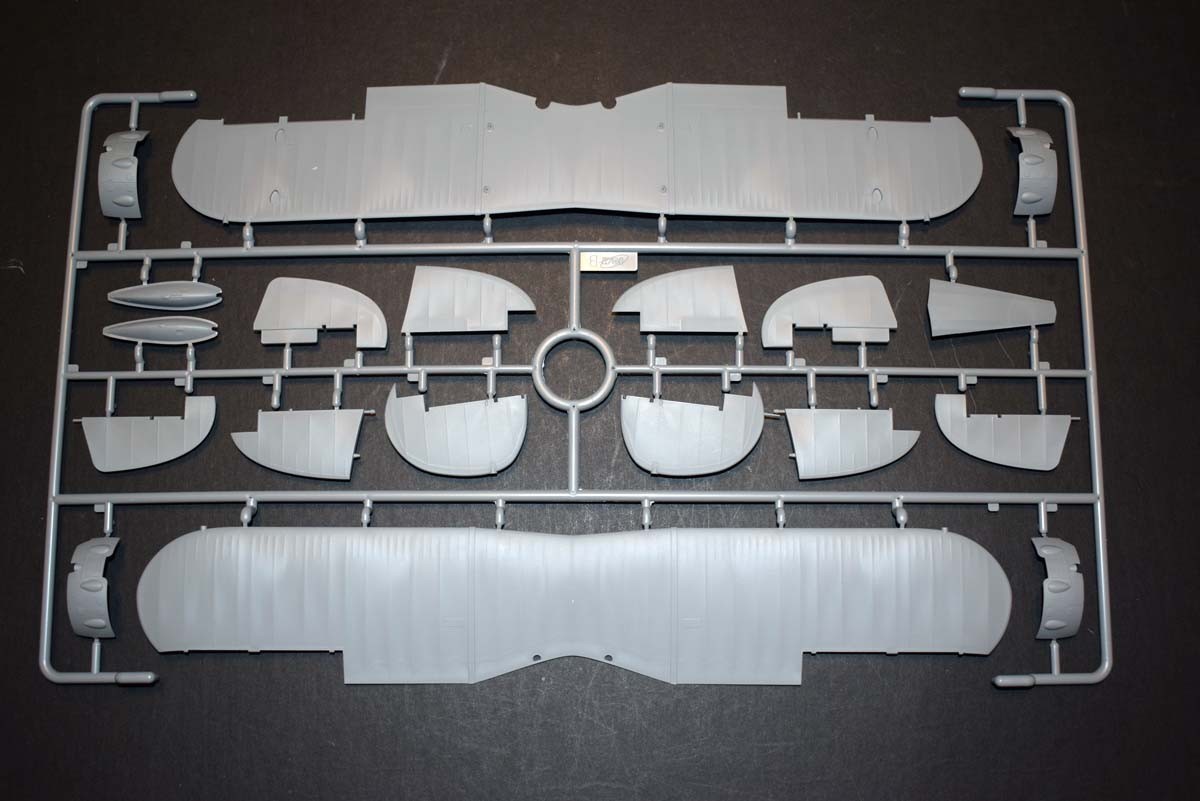
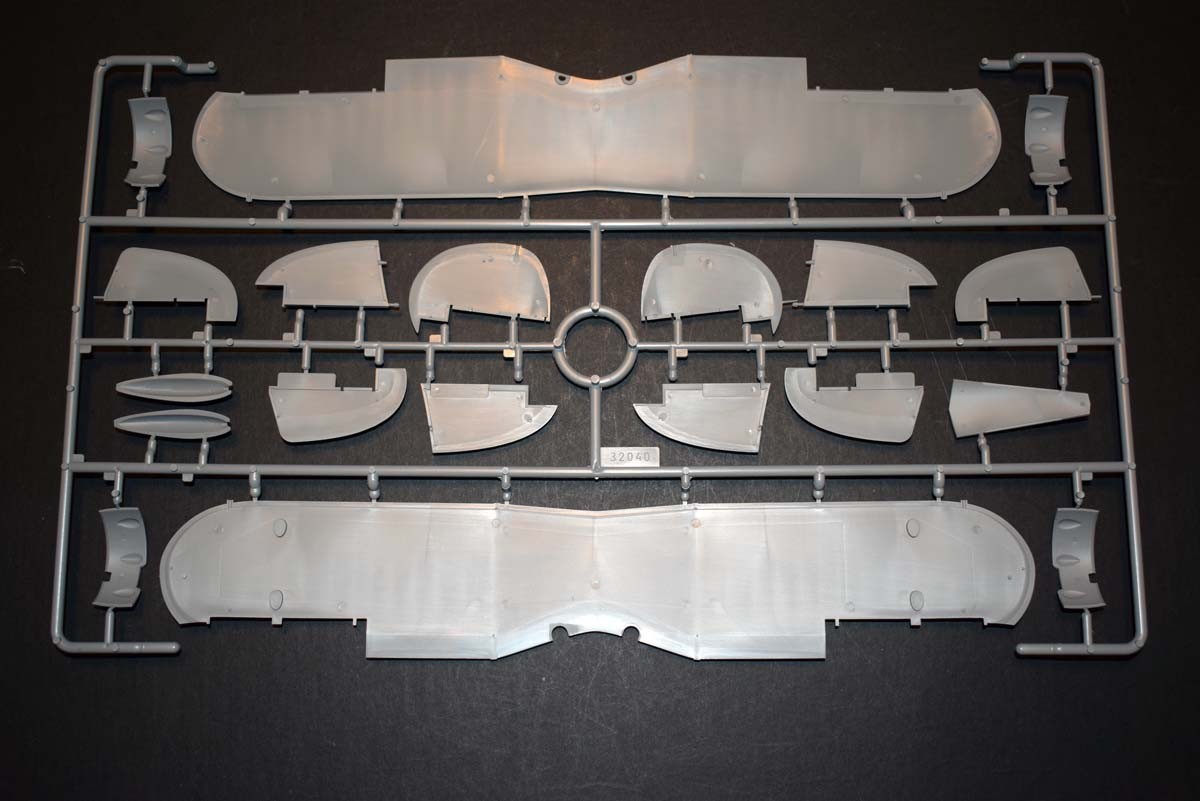


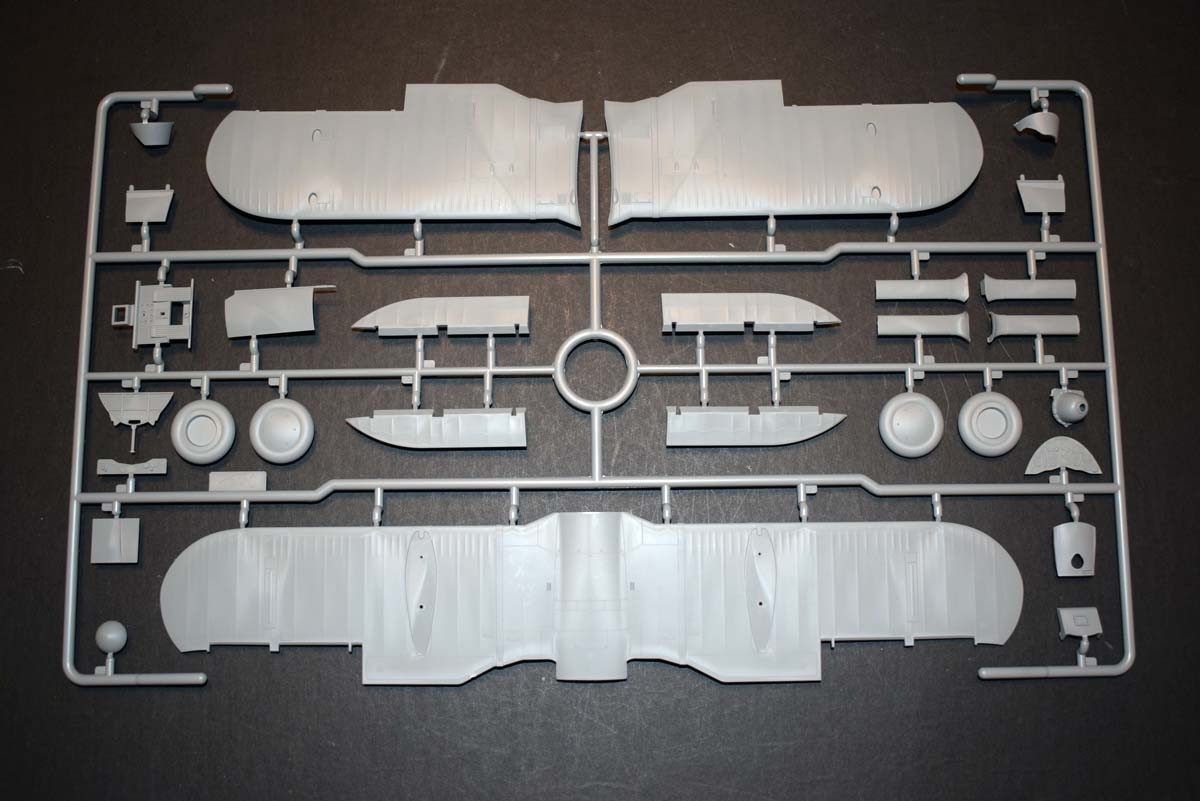
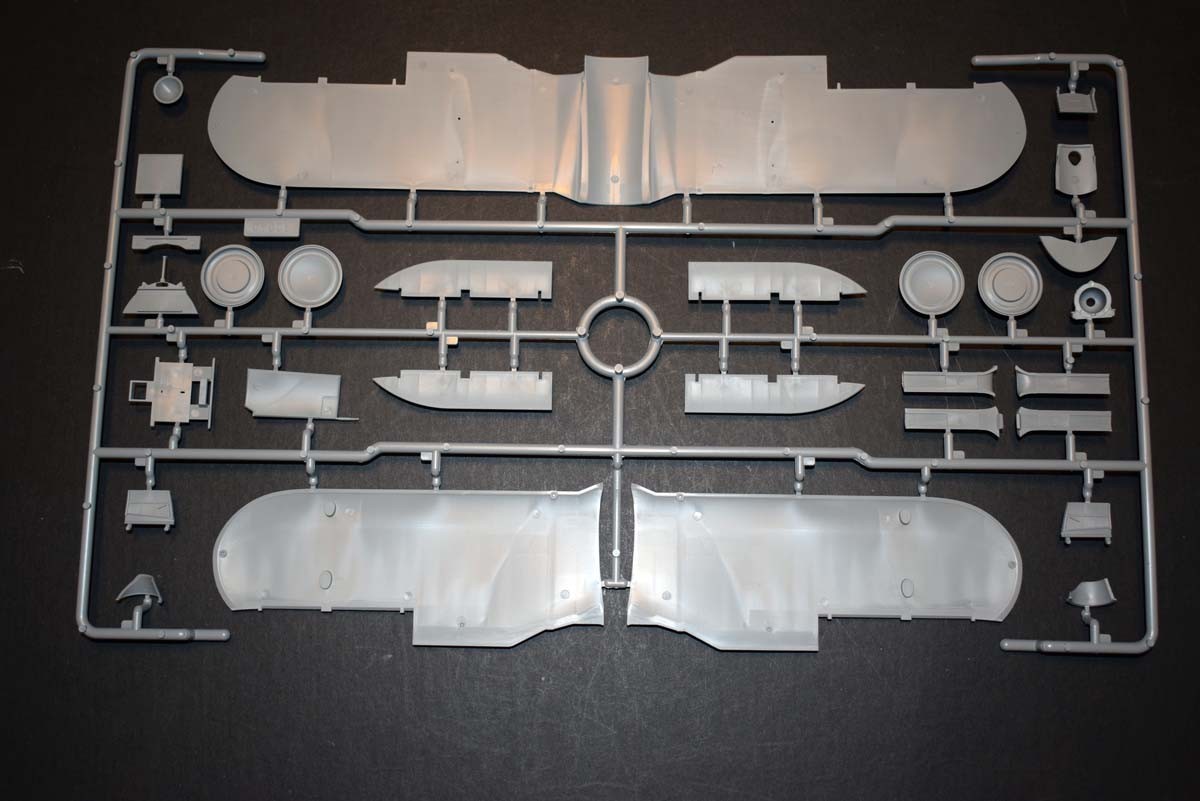
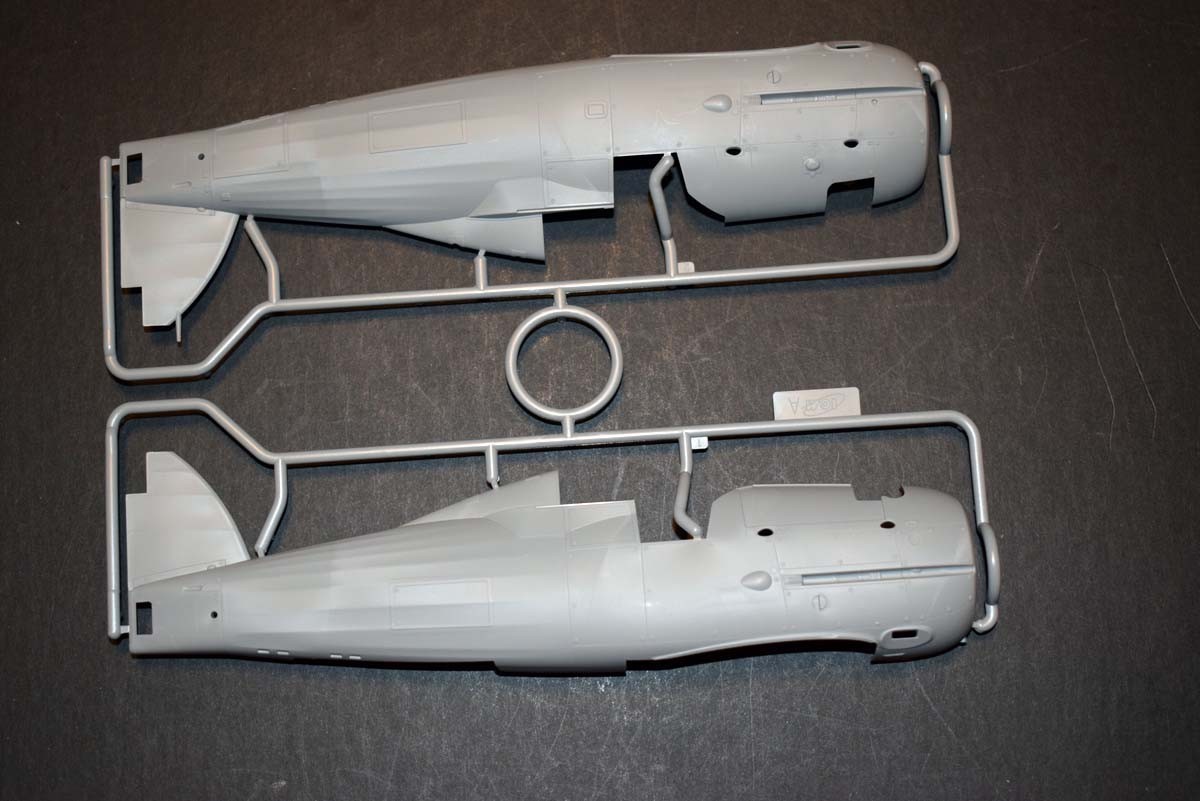

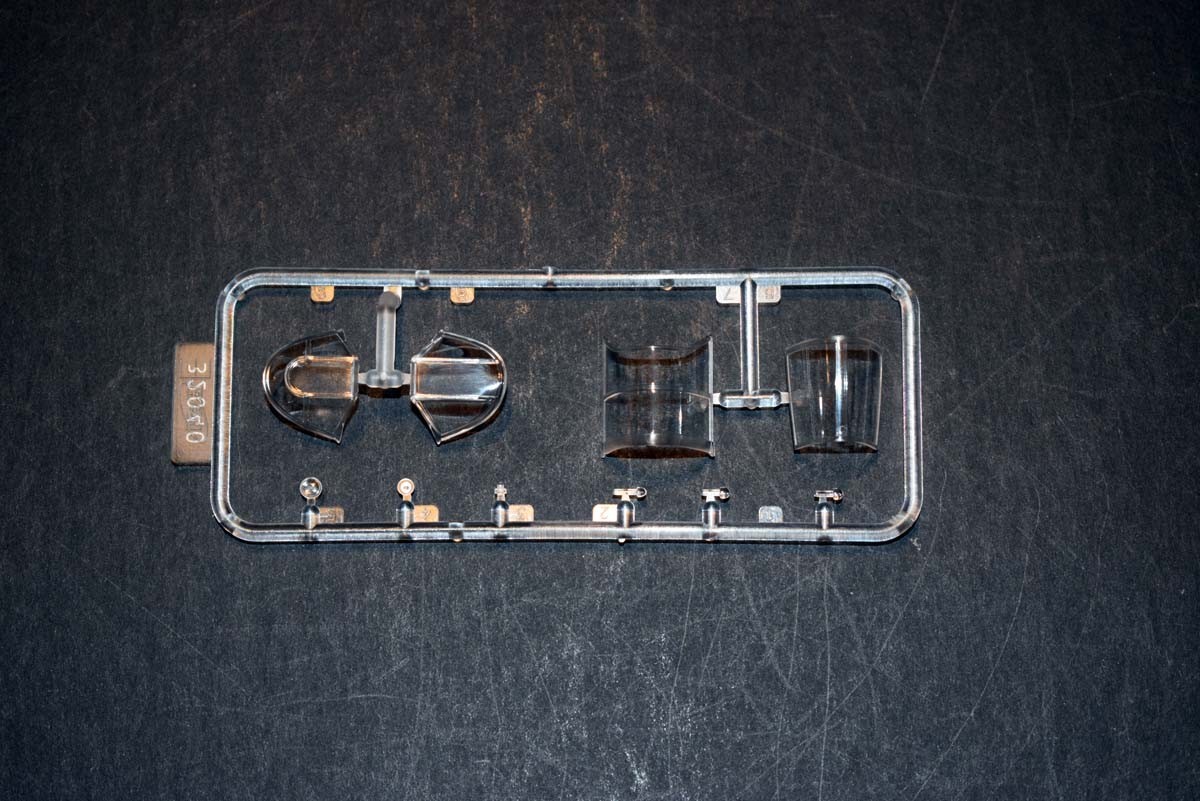
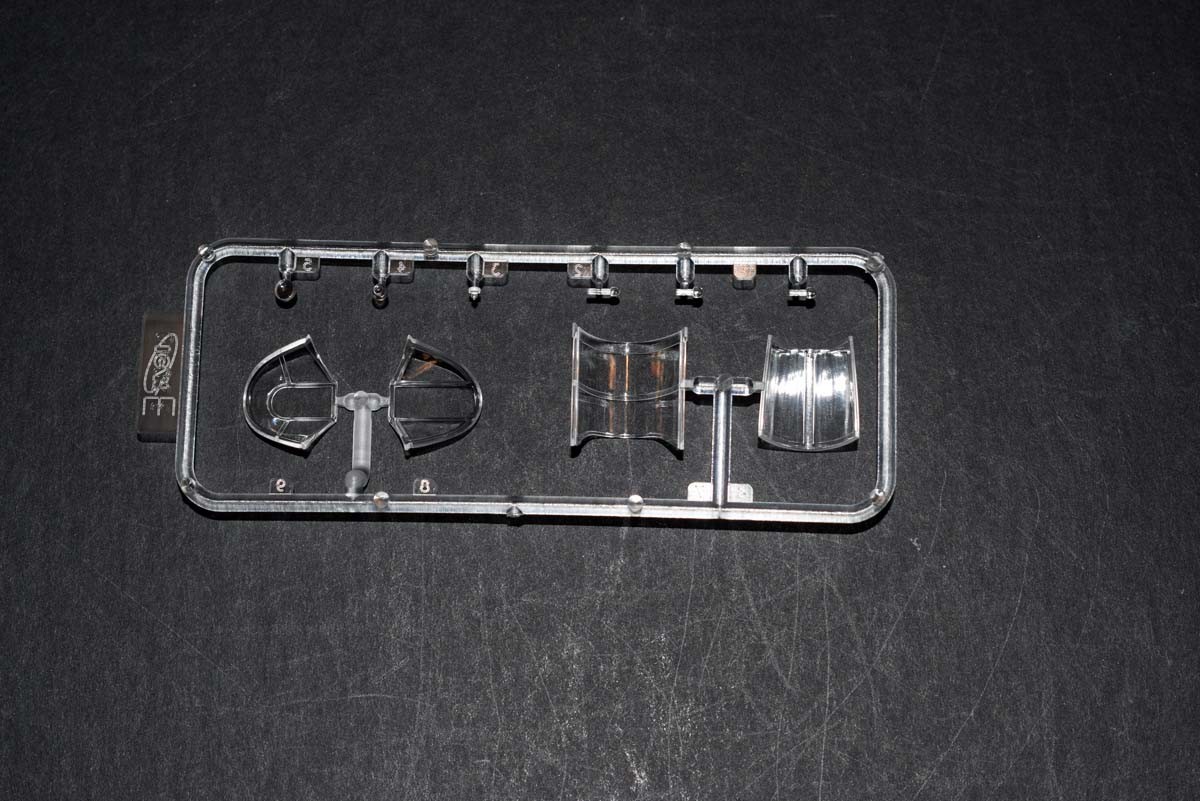
Finishing Options
The finishing options for the model are:
Gloster Gladiator Mk 1, No 72 (F) Squadron, Britain 1938
Gloster Gladiator Mk 1, No 607 Squadron, Britain August 1939
Gloster Gladiator Mk 1, No 112 Squadron, Egypt 1940
Gloster Gladiator Mk 1, Flown by Flight Lieutenant M.T.St.J. Pattle, No 80 Squadron, Amriya, Egypt, early 1940

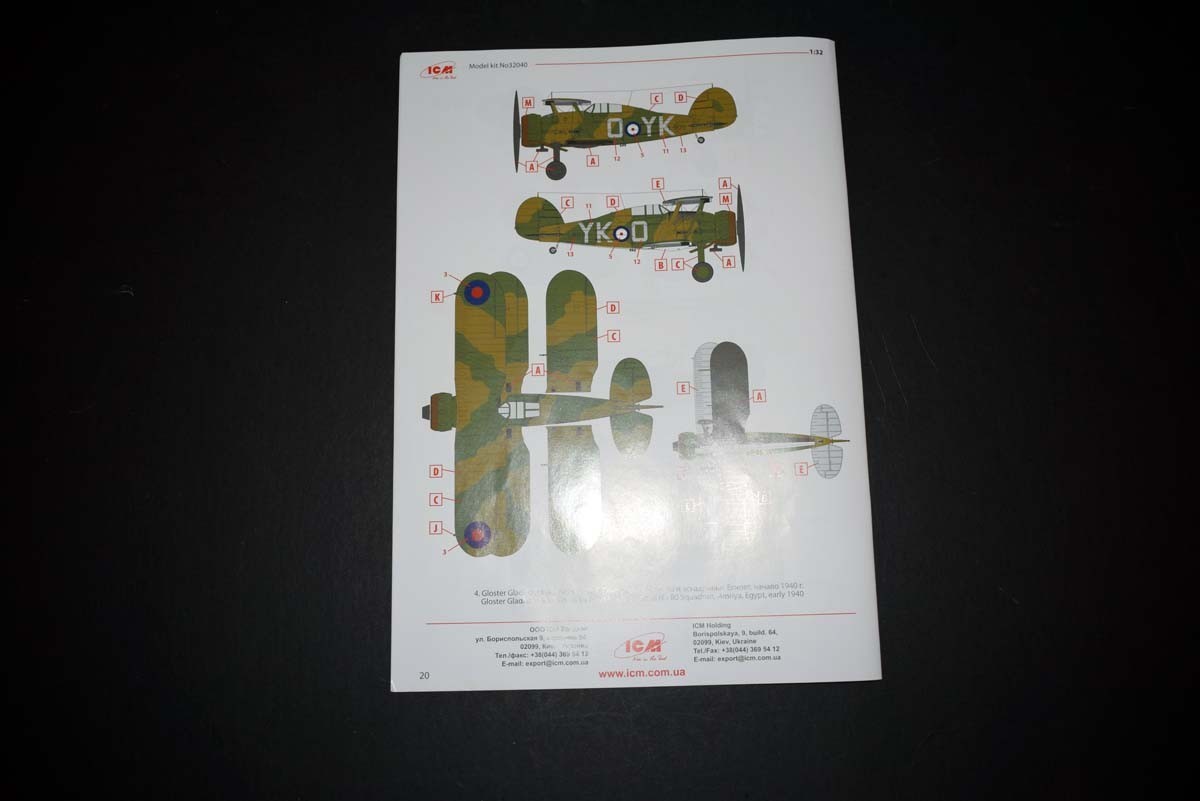
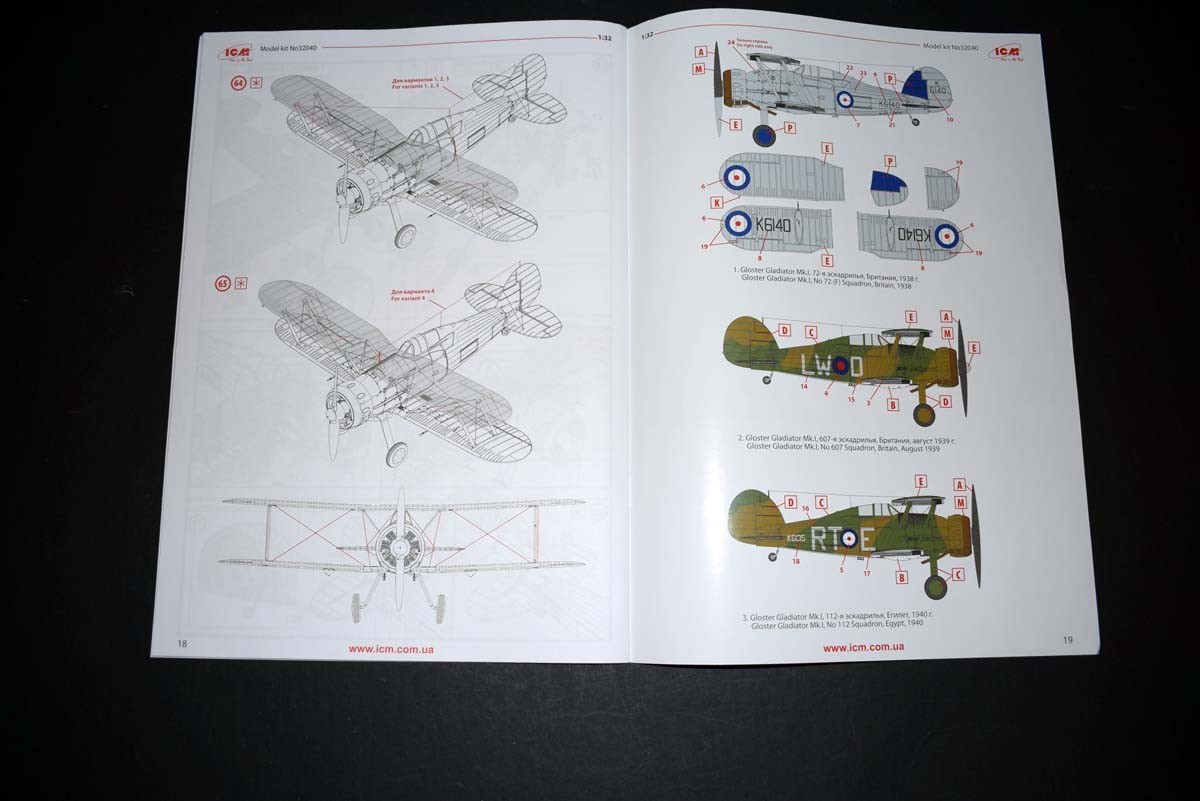
The Figures
All of the figures offered are stood upright and in my opinion have good scale proportions to them. The officer with the clipboard is in shirt sleeve order and looks good in all respects. Crease detail is minimal as is appropriate for the stance and so looks natural. The officers peaked cap has been moulded in two parts and this has enabled some nice detail where the cap badge is concerned. The holstered Webley side arm looks good.
The pilots in the offering are both wearing Mae West’s over short sleeved shirts. One of the pilots has trousers and the other having knee length shorts. In the case of the figure in the shorts I particularly like the effort put into the ribbed military socks. The flying helmets have a good level of detail and the face masks are a very nice detail addition. The only complaint I would make is that the goggles could have done with being clear mouldings in this scale.
The hands on the figures are good with a slight odd to the look on the position of the fingers of one hand. One of the pilots has a hand in a pocket which I am not keen on. Each figure has a wristwatch in place and that is a detail that could easily have been missed. The facial features are especially good in this scale and I cannot see anyone feeling let down by them as even the moustache detail is good where used.
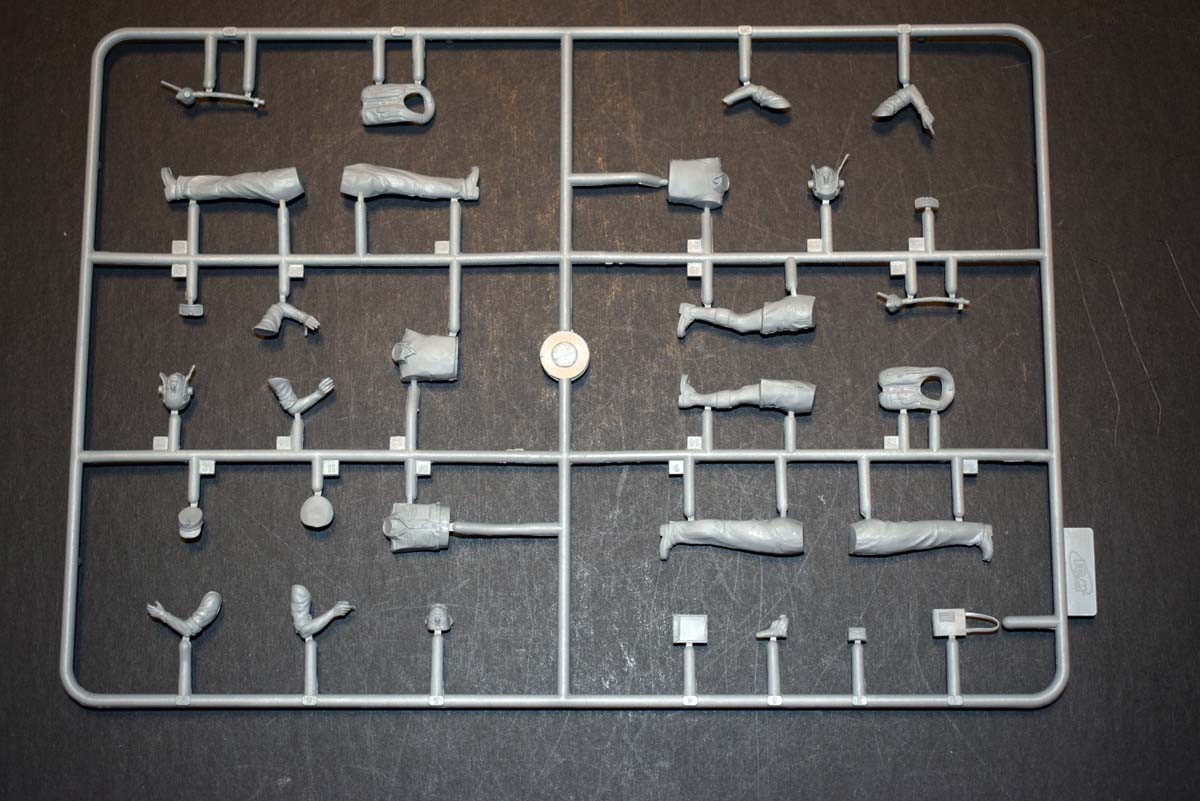

Conclusion
While both of the offerings provided here by ICM have been available previously I am pleased to see them offered together as they work as a single release. On the negatives I can only really complain about the lack of seat harness detail and clear mouldings for the pilot’s goggles. On the plus side is some very nicely moulded parts that offer a great level of detail. The effort put into showing the stringing for the model is especially worth praise as is the facial detail of the three figures.











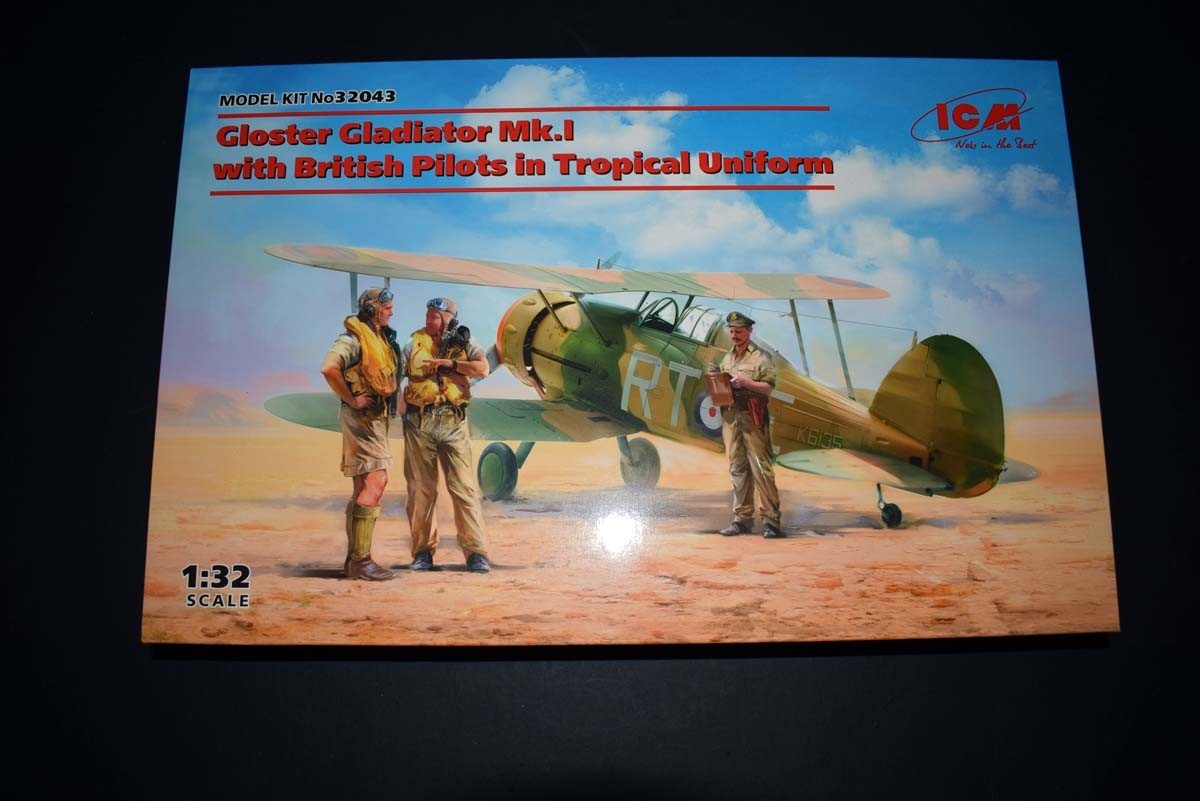













![Junkers F13 [Early Prod] With Winter Skis Coming Soon](/upload/media/posts/2025-07/22/48020-junkers-f13-with-winter-ski-early-prod_1753181324-s.jpg)


